
South Africa occupies the southern tip of Africa, its coastline stretching more than 2,850 kilometres from the desert border with Namibia on the Atlantic (western) coast southwards around the tip of Africa and then northeast to the border with Mozambique on the Indian Ocean. The low-lying coastal zone is narrow for much of that distance, soon giving way to a mountainous escarpment that separates the coast from the high inland plateau. In some places, notably the province of KwaZulu-Natal in the east, a greater distance separates the coast from the escarpment. Although much of the country is classified as semi-arid, it has considerable variation in climate as well as topography. The total land area is 1,220,813 km2 (471,359 sq mi). It has the 23rd largest Exclusive Economic Zone of 1,535,538 km2 (592,875 sq mi).
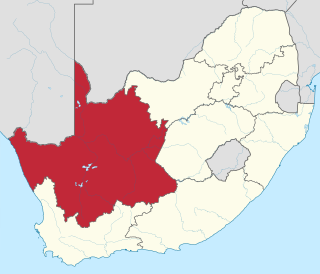
The Northern Cape is the largest and most sparsely populated province of South Africa. It was created in 1994 when the Cape Province was split up. Its capital is Kimberley. It includes the Kalahari Gemsbok National Park, part of the Kgalagadi Transfrontier Park and an international park shared with Botswana. It also includes the Augrabies Falls and the diamond mining regions in Kimberley and Alexander Bay.

The Karoo National Park is a wildlife reserve in the Great Karoo area of the Western Cape, South Africa near Beaufort West. This semi-desert area covers an area of 750 square kilometres (290 sq mi). The Nuweveld portion of the Great Escarpment runs through the Park. It is therefore partly in the Lower Karoo, at about 850 m above sea level, and partly in the Upper Karoo at over 1300 m altitude.

The Succulent Karoo is a ecoregion defined by the World Wide Fund for Nature to include regions of desert in South Africa and Namibia, and a biodiversity hotspot. The geographic area chosen by the WWF for what they call 'Succulent Karoo' does not correspond to the actual Karoo.

The wildlife of South Africa consists of the flora and fauna of this country in southern Africa. The country has a range of different habitat types and an ecologically rich and diverse wildlife, vascular plants being particularly abundant, many of them endemic to the country. There are few forested areas, much savanna grassland, semi-arid Karoo vegetation and the fynbos of the Cape Floristic Region. Famed for its national parks and big game, 297 species of mammal have been recorded in South Africa, as well as 849 species of bird and over 20,000 species of vascular plants.

Aeropetes is a monotypic butterfly genus in the family Nymphalidae. Its only species, Aeropetes tulbaghia, is commonly known as the Table Mountain beauty or mountain pride. It is native to southern Africa, where it occurs in South Africa, Lesotho, Eswatini and Zimbabwe.

Stygionympha vigilans, the western hillside brown, is a butterfly of the family Nymphalidae. It is found in South Africa on the seaward side of the mountains from Cederberg south to the Cape Peninsula in the Western Cape and along the Drakensberg mountains to Grahamstown in the Eastern Cape.
Stygionympha scotina, the eastern hillside brown, is a butterfly of the family Nymphalidae. It is found in South Africa on the seaward side of the mountains from Cederberg south to the Cape Peninsula in Western Cape and along the Drakensberg mountains to Grahamstown in Eastern Cape.

Stygionympha wichgrafi, or Wichgraf's brown, is a butterfly of the family Nymphalidae. It is found in South Africa, Zimbabwe and Mozambique.
Stygionympha curlei, or Curle's brown, is a butterfly of the family Nymphalidae. It is found in South Africa, at high altitudes ranging from 1,500 to 2,000 meters along the Drakensberg mountain-range in northern KwaZulu-Natal and Mpumalanga.
Stygionympha robertsoni, or Robertson's brown, is a butterfly of the family Nymphalidae. It is found in South Africa, in Northern Cape, the southern part of Free State, the northern part of Western Cape and the Eastern Cape.
Stygionympha vansoni, or Van Son's brown, is a butterfly of the family Nymphalidae. It is found in South Africa, in Northern Cape from the Kamiesberge to the Springbok area.
Stygionympha geraldi, or Gerald's brown, is a butterfly of the family Nymphalidae. It is found in South Africa, in succulent Karoo areas inland from the Northern Cape coast.
Tsitana uitenhaga, the Uitenhage sylph, is a butterfly of the family Hesperiidae. It is only known from dry grassy scrubland in the Nama Karoo from the Western Cape to the Eastern Cape in South Africa. The habitat consists of grassy areas and riverbeds in hot, dry, scrubby areas in the southern Karoo.
Tsitana tulbagha, the Tulbagh sylph, is a butterfly of the family Hesperiidae. It is found in South Africa. The habitat consists of grassy, rocky areas in fynbos and Karoo.
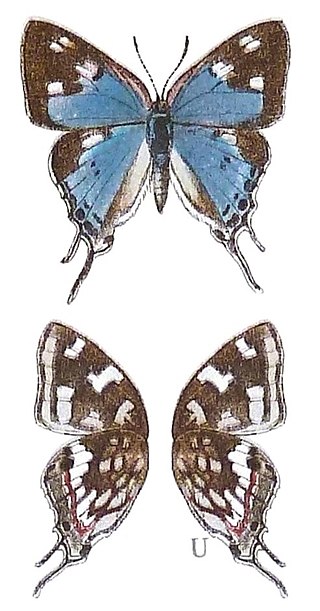
Stugeta subinfuscata, the dusky sapphire, is a butterfly of the family Lycaenidae. It is found in southern Africa.
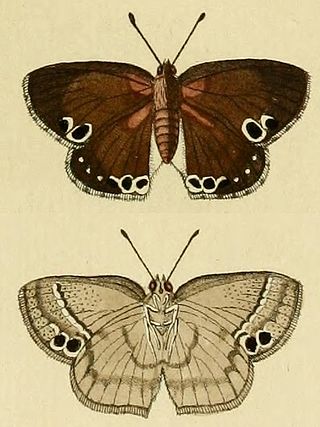
Leptomyrina lara, the Cape black-eye, is a butterfly of the family Lycaenidae. It is found in South Africa, in fynbos, Nama Karoo and Succulent Karoo throughout the Western Cape to the Eastern Cape, the eastern parts of Free State, the mountains of Lesotho and Northern Cape.
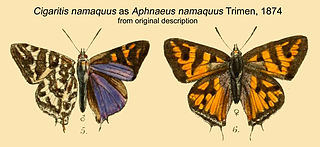
Cigaritis namaquus, the Namaqua bar, is a butterfly of the family Lycaenidae. It is found in South Africa, where it is restricted to the Succulent Karoo areas from the extreme Northern Cape near the border with Namibia, to the northern parts of the Western Cape.
Trimenia macmasteri is a butterfly of the family Lycaenidae. It is found in South Africa, where it is found from Beaufort West to the Roggeveld escarpment in the Western Cape.
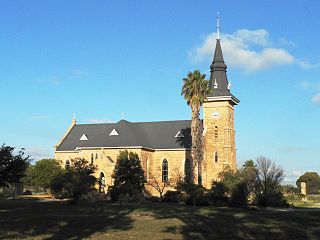
Nieuwoudtville is a town in Namakwa District Municipality in the Northern Cape province of South Africa. The town lies on the Bokkeveld Escarpment, and was established in 1897. The Nieuwoudtville Falls on the Doring River are located a few kilometres north of the town.











